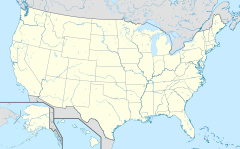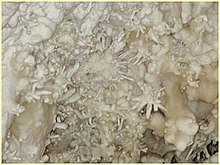Timpanogos Cave National Monument
| Timpanogos Cave National Monument | ||
|---|---|---|
| "Great Heart of Timpanogos" | ||
|
|
||
| Location: | Utah , United States | |
| Next city: | Provo | |
| Surface: | 1 km² | |
| Founding: | August 10, 1933 | |
| Visitors: | 105,000 (2005) | |
Timpanogos Cave [ tɪmpəˈnəʊgəz ˌkeɪv ] (German Timpanogos Cave ) is the eponymous cave for a stalactite cave system in the north flank of Mount Timpanogos . It is located in the Wasatch chain in the US state of Utah - near American Fork and not far from the state capital Salt Lake City . The caves were discovered between 1887 and 1921 and are designated a National Monument by the National Park Service .
The park
The park is located in the particularly steep American Fork Canyon of the Wasatch Range, a mountain range of the Rocky Mountains . The slope on which the caves are located ranges from around 1600 to over 3000 m. Even on the surface, the park area is particularly diverse in view of its small size. In the valley of the American Fork River there is a riparian forest with cottonwood poplars and ash maples . The vegetation then changes with the increasing height over subalpine to alpine plant communities. The fauna of the valley ranges from mountain goats to bighorn sheep and pumas to black bears .
In the limestone, fossils of Rugosa , starfish and arm pods are found both on the surface and in parts of the cave .
The caves
The cave system consists of three larger and several smaller caves, which were artificially connected by tunnels. The Hansen Cave was found in 1887 by the settler Martin Hansen while cutting wood. He was fascinated by the diverse stalactite formations and led visitors into the cave. After a few years, the cave was plundered, the stalactites and sintered curtains had ended up in museums and private collections or made into handicrafts.
In 1915 the Timpanogos Cave was discovered and initially forgotten. In 1921 it was rediscovered and a third cave - called the "Middle Cave" - was found. Initiatives now arose to protect the caves, and as early as the next year US President Warren G. Harding initially placed the caves under the temporary protection of the United States Forest Service before the National Monument was taken over by the National Park Service in 1933 .
The Hansen Cave today contains only a few remarkable formations, but is important for the constant climate in the caves because of its underground lake. In the middle cave sinter curtains stand out and the attached "large room" shows a great variety of sinter formations.
The core of the cave system is the Timpanogos Cave. Here, several hanging stalactites grown together "Heart of Timpanogos" and here are large parts of the walls with Excentrique (fr. "Eccentric" for) covered. These are the finest structures made of calcite that form protrusions that are curved in all directions. The origin is completely unexplained, as the forms are not influenced by gravity. Some eccentrics are hollow so that capillary effects can come into play. In the case of the more common massive eccentrics, this attempt at explanation is insufficient.
Tourist facilities
The Timpanogos Cave National Monument is a small protected area and consists only of visitor information in the valley and the actual caves in the mountain. A steep path about 2.4 kilometers long leads to the entrance. There are only minor differences in altitude to be overcome in the caves.
The visitors are led by rangers in groups of no more than 20, with a minimum of 10 minutes apart. In summer it is advisable to make a reservation, as waiting times of several hours can occur due to the capacity limit being reached.
There are no accommodations in the park itself, in the valley of the American Fork River there are several campsites of the US Forest Service. There are motels in the towns west of the mountains, hotels in Salt Lake City, and suburbs.
Web links
- National Park Service: Timpanogos Cave National Monument (official site; English)
- Virtual tour through the caves



